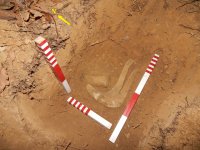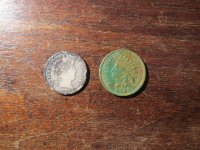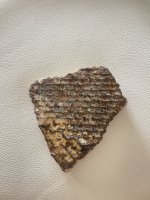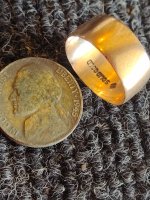bonepicker
Bronze Member
Hello again, I recently purchased the DEUS with the 9" coil. Still reading the owners manual, and starting to read andys book.
Still using basic1 and turning up the sensi a little. Freq at 8Khz. I finally got permission to hunt this house that was built around 1900. I put several hours in and didn't get one coin from before 1960. Most of these coppers and dimes that I chose to dig were around 7"es. I saw some layers of sand mixed in with the topsoil in some areas, looks like the area could have had a little fill, but it was close to level with the street.
Most of these coppers and dimes that I chose to dig were around 7"es. I saw some layers of sand mixed in with the topsoil in some areas, looks like the area could have had a little fill, but it was close to level with the street.
I waited to get permission on this house for a long time, and just knew when I finally did I was gona kill it......
This old house is next door to my mother's, and I was told it used to be in our family.
Someone told me that I would have days where I would love the DEUS and days where I would hate it. Well today I was not lovin it.
Was wondering if someone could give me some advice in order to get more depth with the 9" coil.
Im really starting to regret getting the 9", but I think once I learn the machine I will get more depth.
Would also like to try some new programs, was wondering if someone could tell me where to find some, or possibly share some with me.
Im near the southern coastline, the mineralization is not bad here. Most of the soil is semi sandy, to rich black with earth worms.
The mineralization levels on my remote are very low (2 bars). and my GMI is normally mid/upper 80's to upper 70s.
I hit one 3 coin spill that rang up as a good 92 at 7"es from all directions. I thought for sure this was a silver quarter. It ended up being a 1969 penny, and a 1960 penny and 1965 dime stuck together. Everytime I would get a good deep deep signal, I would rotate 90 degrees and the signal would either change, or if it stayed close to the same, it would end up being some kind of trash.
Was just one of those days..
I almost went home to go get my Whites XLT.
Still using basic1 and turning up the sensi a little. Freq at 8Khz. I finally got permission to hunt this house that was built around 1900. I put several hours in and didn't get one coin from before 1960.
I waited to get permission on this house for a long time, and just knew when I finally did I was gona kill it......
This old house is next door to my mother's, and I was told it used to be in our family.
Someone told me that I would have days where I would love the DEUS and days where I would hate it. Well today I was not lovin it.

Was wondering if someone could give me some advice in order to get more depth with the 9" coil.
Im really starting to regret getting the 9", but I think once I learn the machine I will get more depth.
Would also like to try some new programs, was wondering if someone could tell me where to find some, or possibly share some with me.
Im near the southern coastline, the mineralization is not bad here. Most of the soil is semi sandy, to rich black with earth worms.
The mineralization levels on my remote are very low (2 bars). and my GMI is normally mid/upper 80's to upper 70s.
I hit one 3 coin spill that rang up as a good 92 at 7"es from all directions. I thought for sure this was a silver quarter. It ended up being a 1969 penny, and a 1960 penny and 1965 dime stuck together. Everytime I would get a good deep deep signal, I would rotate 90 degrees and the signal would either change, or if it stayed close to the same, it would end up being some kind of trash.
Was just one of those days..
I almost went home to go get my Whites XLT.
Amazon Forum Fav 👍
Last edited:








